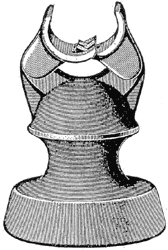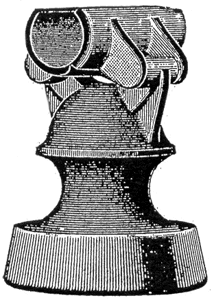[Trade Journal]
Publication: Western Electrician
Chicago, IL, United States
vol. 20, no. 16, p. 223, col. 3
H. W. J. Toggle Clamp Feed-wire Insulator.
The increasing demand for the larger sizes of feed cables on electric railways has from time to time necessitated improvements in pole insulators with a view of obtaing greater strength, higher insulation and a wider seat for the better protection of teh insulating covering. Were it not for the constant contractions, expansions and other movements which cause the wire to shift in its seat, there would be little object in securing the wire to the insulator with the care that is exercised at present.
 |
| H. W. J. Toggle Clamp Feed-Wire Insulator. |
 |
| H. W. J. Toggle Clamp Feed-Wire Insulator. |
The kinds of fastenings at present employed may be briefly mentioned as the tie wire, top groove with metal fingers to be hammered over on the wire, and teh top groove with screw-cap retainer. All of these methods possess disadvantages, not only for the reason that they do not altogether prevent slipping and wear and tear of the insulating covering, and consume the time of the lineman in attaching the wire to the insulator, but on account of the difficulties in detaching the cable without loss of time or of damage to insulating covering or insulator. With the view of reducing to a minimum these disadvantages and also to include a feature which would permit the immediate removal of the wire from the insulator without the necessity of cutting the tie wire, bending back the metal fingers or loosening a screw cap which may have rusted in place, the H. W. J. toggle clamp insulator has been designed. As will be seen from the illustrations, the body of the insulator is in all respects similar to the forms which have become familiar to the users of the feed-wire insulators of the H. W. Johns Manufacturing company. The improvement consists in the addition of jaws for the receipts of the wire, hinged at the sides in such manner as to grasp the wire firmly as they come together with a powerful toggle action. As the weight of the wire causes the jaws to descent, the descending movement has a tendency to force the jaws closer together, and the greater the downward strain the greater will be clamping action. The principle of the toggle has been so nicely applied in the present instance as to form what appears to be a satisfactory, reliable and perfectly automatic clamp for the feed wire. The jaws are three inches long, thus providing an unusually large and desirable resting place for the insulating covering. The action of the clamp is instantaneous. All that is necessary to insert the wire is to open the jaws slightly and drop the wire into place. Although the wire is held in a vise-like grasp, it is readily removed by simply lifting it out of the insulator. The utility of such an instantaneous and automatic form of clamp will be apparent. The feed cable may be strung in accordance with present practice, and may be dropped into the insulators without other cost or effort than that necessary for the lineman to drop the wire into the jaws. If for any reason it becomes necessary to shift or adjust the line, the operation becomes an exceedingly simple and economical one.
